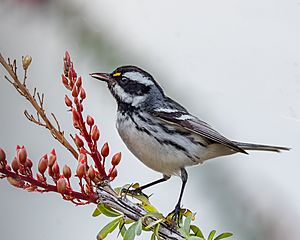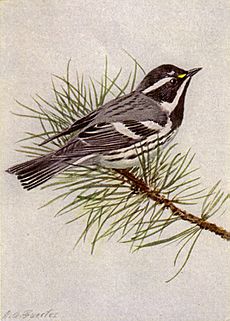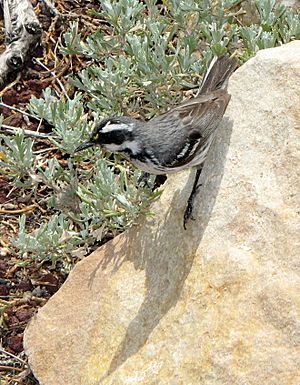Black-throated gray warbler facts for kids
Quick facts for kids Black-throated gray warbler |
|
|---|---|
 |
|
| Male | |
| Conservation status | |
| Scientific classification | |
| Genus: |
Setophaga
|
| Species: |
nigrescens
|
 |
|
| Breeding range Winter range | |
| Synonyms | |
|
Sylvia nigrescens Townsend, 1837 |
|
The black-throated gray warbler (Setophaga nigrescens) is a small songbird. It belongs to the New World warbler family. This bird is about 13 cm (5 inches) long. It has gray and white feathers with black marks.
Male warblers have a bold black throat, which gives them their name. They also have black stripes on their head and black streaks on their sides. Females look similar but are paler. Their throats are white, and their black markings are not as clear.
These warblers breed in western North America. This area stretches from British Columbia to New Mexico. They spend their winters in Mexico and the southwestern United States. They like to live in coniferous forests, mixed forests, and scrubland. They especially like areas with pinyon pines, junipers, sagebrush, and oak trees.
Their nest is shaped like an open cup. It is made of plant fibers and lined with soft feathers. They build it a few meters off the ground in a tree or bush. Females lay three to five eggs. Both parents help feed the young birds. This warbler is common where it lives. It is not currently in danger from human activities, unlike many other birds that migrate.
Contents
About the Black-throated Gray Warbler
How the Bird Got Its Name
The black-throated gray warbler was first described by a person named John Kirk Townsend. He found a bird near what is now Portland, Oregon. The Chinook people, who lived there, called this bird Ah Kah a qual.
Townsend first put this bird in a group called Sylvia. Now, scientists place it in the Setophaga group. This group includes about thirty other warbler species.
Warbler Relatives
The black-throated gray warbler is related to birds like the hermit warbler and Townsend's warbler. These birds also have black throats and yellow markings on their faces. Even though they live in some of the same areas, they prefer different types of habitats. It is rare for the black-throated gray warbler to mix with these other warblers.
Scientists have found two slightly different types, or subspecies, of this bird. One type, S. n. nigrescens, lives along the Pacific coast. The other, S. n. halseii, lives more inland. The inland birds are a bit larger and grayer.
What the Black-throated Gray Warbler Looks Like
The black-throated gray warbler has soft feathers that are mostly black, gray, and white. It has stripes and a small yellow spot between its eye and beak. This makes it easy to recognize.
Both males and females have gray backs with black streaks. Their undersides are white with black streaks on their sides.
- Adult males have black stripes on their head, throat, and below their eye. They have white around their chin and above their eye.
- Adult females have duller colors on their head. Their throat is white, and their cheeks are dark gray.
Other birds like the black-and-white warbler and blackpoll warbler also have black marks. But their feather patterns are very different.
This warbler is usually about 13 cm (5 inches) long. It weighs about 8.4 grams (0.3 ounces). Its wings are about 5.6 to 6.9 cm (2.2 to 2.7 inches) long. Its tail is about 4.7 to 5.5 cm (1.8 to 2.1 inches) long. Females are usually a little smaller than males. Their wingspan is about 19 to 19.7 cm (7.5 to 7.8 inches).
Calls and Songs
This bird makes a sharp tup or thick sound. It also has a high see sound it makes when flying. The male's song is a series of buzzing notes. The first notes are often repeated, and the second-to-last note is high. Males also have a quiet "soft song" they sing when following females.
Where the Black-throated Gray Warbler Lives
The black-throated gray warbler breeds in western North America. Its breeding range goes from southwestern British Columbia down the Pacific coast to northern Baja California. It also extends east to New Mexico and southern Montana.
Most of these birds spend their winters in Mexico. This includes areas from southern Baja California to Oaxaca state. Recently, they have started to spread into parts of Wyoming and Montana. This is because a type of juniper tree is growing more in these areas due to a warmer climate. Sometimes, these birds fly far off course. They have been seen in eastern North America and even in Cuba.
Preferred Habitats
The black-throated gray warbler likes to breed in open coniferous forests. It also lives in mixed forests with lots of bushes. Dry open oak forests and chaparral (a type of scrubland) are also good homes for them. They are often found near pinyon pines, junipers, and oak trees.
They fly south in late fall for winter. They return north in mid-spring. During their migration, they look for food in any woods or scrub they pass through. In their winter homes, they live in dry woodlands and tall scrub.
Conservation Status
This warbler is quite common. It is one of the most common birds in some places. Because its numbers are stable and not quickly declining, it is listed as "Least Concern" on the IUCN Red List. This means it is not currently in serious danger.
Black-throated Gray Warbler Behavior
The black-throated gray warbler is usually easy to get close to. This makes it easy to watch them find food. Even so, scientists don't know much about their breeding habits.
They often look for food in groups with other bird species. They eat insects, especially caterpillars. They pick these insects off low branches.
Nesting and Young
The nest is usually built on a tree branch or in a bush. It is typically a few meters above the ground. The nest is an open cup made of grass stems and other plant fibers. It is lined with soft feathers and animal hair.
The female lays three to five pinkish eggs with brown dots. This happens between May and July. Scientists don't know exactly how long the eggs take to hatch or how long the young stay in the nest.
This bird has been seen doing a "distraction display". This is when a parent pretends to be hurt to lead predators away from its nest. Both parents help feed the young birds. However, the female might feed them more often.
See also
 In Spanish: Reinita gris para niños
In Spanish: Reinita gris para niños




